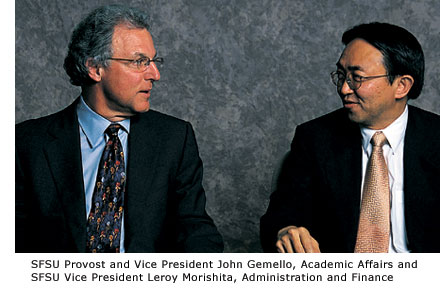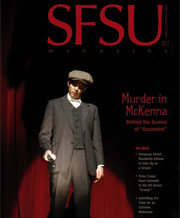Budget Q and A In May, Governor Schwarzenegger, the CSU and the UC reached agreement on a six-year compact, designed to provide fiscal stability for California higher education (see sidebar, next page). As a result, SFSU will have a much better idea of what its future budgets will look like. San Francisco State President Robert A. Corrigan said that the compact "stops the bleeding for next year, but it does not restore the millions we have lost." Indeed, San Francisco State has been grappling with multi-million dollar cuts in state support over the past three years, cuts that are permanent reductions to its budget. SFSU Magazine editors sat down in May with John Gemello, provost and vice president for academic affairs, and Leroy Morishita, vice president for administration and finance, to discuss California's budget crisis and its effect on the University. Why does SF State have to make such drastic cuts to its budget?
Morishita: The CSU has taken cuts to its budget of more than $560 million over a three-year period. SF State's share of this is more than $31 million. If we did not have to absorb these cuts we would have about $250 million in our budget next year compared with less than $220 million that we'll have now. That's a staggering loss in revenue. After the budget crisis of the 1990s, no part of the University has come back to where it once was. That's the difficult part. We're cutting on top of the cuts we absorbed in the early 1990s. Gemello: I think the answer is that we really don't have a choice. We have two sources of money for the University: student fees and money that comes from the state -- and the latter has been cut drastically. Even with the dramatic student fee increases, our budget is far below what it was previously. We have to live with fewer dollars. What strategy did you use to make the cuts?
Gemello: The magnitude of the cuts is so great it has pushed us beyond the point of short-term fixes. Having made across-the-board cuts to SFSU's budget previously, we felt we couldn't do that again without seriously affecting the quality of the academic program. In Academic Affairs I met with each of the deans this spring and encouraged them to work with their department chairs and faculty to make sure there was broad participation in discussions about proposed cuts. When the deans and I met again, we went through their proposals to see where they could make reductions. Given the magnitude of what we were faced with and how complex the institution is, we tried hard to keep the process as open and consultative as possible. Morishita: Rather than an across-the-board approach to the cuts, which would weaken the entire University, we focused more on making some deeper but narrower cuts to preserve the academic program as much as possible. Why did you decide to do it that way?
Gemello: In Academic Affairs, our budget two years ago was $118 million. Now it's $107 million. The question I asked this spring as I went around the campus was: "What if we were building a university from scratch and we had $107 million? What would it look like?" And my guess is it wouldn't look like it does now, with everything cut back a little bit. It's more likely there would be things we wouldn't do. And that's really how we approached it. We were trying to say, "Which academic programs are possible with a $118 million budget, but are not possible with $107 million?" Morishita: The other difficult part is that most of the University's dollars are in people. About 79 percent of our budget goes to pay salaries and benefits. We really have very few discretionary dollars to cut. Only 6.5 percent of our budget lies in the area people think of first for cuts: operating expenses. Will the cuts be made immediately?
Gemello: The plan includes a variety of strategies: discontinuing some programs, moving some to self-support, downsizing others, phasing out general fund support for remediation, and achieving savings by consolidating some elements of the General Education curriculum, among others. Recommendations for program discontinuance must go to the Academic Senate for deliberation this fall. Changes can be made, but the reductions within Academic Affairs must total $10.6 million. Some elements in the plan are being implemented immediately. But much of the plan comprises long-term strategies. We expect the savings from discontinued programs, for example, to take full effect in fall 2006. How are faculty and students affected?
Gemello: The current plan preserves all tenured and tenure-track faculty jobs, although some faculty would be moved to other programs or departments. We will lose a significant number of lecturer positions. Discontinued programs will be phased out gradually, allowing current students to complete their degrees. However, no new students will be accepted in areas considered for discontinuance. Are budget cuts forcing SFSU to limit its enrollment in the fall?
Morishita: For 2004-05, the CSU reduced its enrollment target by 5 percent. To comply with the CSU's request, we are taking no lower-division transfer students or second baccalaureate students this year. Because of careful planning, however, SFSU will not deny admission to anyone who applied by our deadlines and is admissible. We set much earlier deadlines for first-time freshmen and upper-division transfer students this year. Even with the early deadlines, we may set a record for first-time freshmen enrollment in the fall. What is happening with Athletics?
Morishita: The Athletics program is taking $1.4 million in cuts. As a result, five sports teams are being eliminated next year, leaving 11. A task force on SFSU athletics will convene during the summer to look at what kind of sports program SFSU should have in the future. Recommendations will be made to President Corrigan in the fall. What was the outcome of the student fee referendum this spring?
Gemello: On a campus that has never had more than 2,000 students vote in any election, 8,558 students voted in the March referendum. Of those, 75 percent voted to approve a fee of $75 a semester to preserve 575 course sections that would otherwise be canceled because of budget cuts. I think it was a really dramatic statement by the students, one that sent a message throughout the state. The students also approved fees to support student health services and the career center. They narrowly defeated a proposal to increase student athletic fees. Are student fees going up again?
Morishita: Fees have risen 40 percent over the last two years. They will increase again in 2004-05 -- 14 percent for undergraduates, 25 percent for graduate students, and 20 percent for credential students. It's important to remember that we had gone eight years without a fee increase and, in fact, there had even been a fee decrease during that time. The good news is that the student fee increases are matched by increases in financial aid. How do SFSU's fees compare with other universities' fees?
Morishita: A national comparison of the CSU with 15 comparable institutions shows that we are at the absolute bottom in cost. Even with the new fees in the fall, we still charge the lowest fees for resident undergraduate students. How will the compact help us?
Morishita: The higher education compact helps to establish a new baseline, a new floor. It guarantees increased general fund dollars starting in 2005-06. It will fund annual enrollment growth for the CSU through 2010-11, ensuring student access. It will also provide predictability for students in terms of fee increases. Gemello: I think it also validates the approach we took with the budget cuts. What we said was, "We're going to have to take some tough medicine. When exactly do we take it?" This year we worked hard and made some really tough decisions. But we're not finished. We still have to implement those decisions. We will work with the Academic Senate next year and see if we're going to do all the things we planned. When we're done we will have readjusted the University to the new lower level of revenue. And then we can start talking about growth, we can start talking about what we are going to do in 2005-06 when we have additional funds. For the past two years, the University has been engaged in discussions about where we should be putting our energies. Starting in 2005-06 there may be some funding to allow us to support the priorities we've identified. The good news about the compact is that we can start planning for the future and start moving forward. -- Janet Wade Higher Education Compact 2005-06 to 2010-11 See How the University plans on cutting its budget by $23 million for 2004-2005.  
| 









